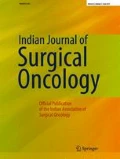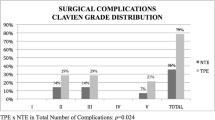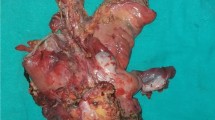Abstract
Pelvic exenteration (PE) is one of the most drastic operations in surgical oncology, associated with severe morbidity and mortality. The objective of our study was to review our experience of PE in terms of surgical characteristics, complications, and overall survival. All patients who had PE surgery between January 1999 and December 2015 were identified. Patients with verified distant metastatic disease were excluded. Patients with advanced pelvic tumors experiencing incapacitating postradiation severe damages were included. The following parameters were recorded: age, sex, indication for surgery, tumor histology, type of exenteration, urinary tract and colon reconstruction methods, operative time, blood transfusion, intensive care unit admissions, length of hospital stay and readmissions, and characteristics of perioperative morbidity and mortality. A total of 25 patients were submitted to PE by our surgical team. Most of the patients suffered from cervical cancer followed by bowel cancer. There was no perioperative mortality. Early postoperative complications ensued in 56% of the patients. Most complications involved the urinary system. Five years survival was estimated at 38%. Most patients (n = 9, 36%) died due to their primary disease, 5 (20%) died because of complications following operation, and 2 (8%) died because they denied oral feeding, which was associated with depression. Patients with a variety of malignancies can benefit from PE. Meticulous surgical technique, perioperative care, counseling, and nutritional support play an important role.
Similar content being viewed by others
References
Brunschwig A (1948) Complete excision of pelvic viscera for advanced carcinoma; a one-stage abdominoperineal operation with end colostomy and bilateral ureteral implantation into the colon above the colostomy. Cancer 1:177–183
Milne T, Solomon MJ, Lee P, Young JM, Stalley P, Harrison JD, Austin KK (2014) Sacral resection with pelvic exenteration for advanced primary and recurrent pelvic cancer: a single-institution experience of 100 sacrectomies. Dis Colon Rectum 57:1153–1161. https://doi.org/10.1097/DCR.0000000000000196
Petruzziello A, Kondo W, Hatschback SB, Guerreiro JA, Filho FP, Vendrame C, Luz M, Ribeiro R (2014) Surgical results of pelvic exenteration in the treatment of gynecologic cancer. World J Surg Oncol 12:279. https://doi.org/10.1186/1477-7819-12-279
Jäger L, Nilsson PJ, Rådestad AF (2013) Pelvic exenteration for recurrent gynecologic malignancy: a study of 28 consecutive patients at a single institution. Int J Gynecol Cancer 23:755–762. https://doi.org/10.1097/IGC.0b013e318287a874
Kusters M, Austin KK, Solomon MJ, Lee PJ, Nieuwenhuijzen GA, Rutten HJ (2015) Survival after pelvic exenteration for T4 rectal cancer. Br J Surg 102:125–131
Hope JM, Pothuri B (2013) The role of palliative surgery in gynecologic cancer cases. Oncologist 18:73–79. https://doi.org/10.1002/bjs.9683
Iavazzo C, Vorgias G, Akrivos T (2008) Laparoscopic pelvic exenteration: a new option in the surgical treatment of locally advanced and recurrent cervical carcinoma. Bratisl Lek Listy 109:467–469
Dindo D, Demartines N, Clavien PA (2004) Classification of surgical complications: a new proposal with evaluation in a cohort of 6336 patients and results of a survey. Ann Surg 240:205–213
Diver EJ, Rauh-Hain JA, Del Carmen MG (2012) Total pelvic exenteration for gynecologic malignancies. Int J Surg Oncol 2012:693535. https://doi.org/10.1155/2012/693535
Schmidt AM, Imesch P, Fink D, Egger H (2012) Indications and long-term clinical outcomes in 282 patients with pelvic exenteration for advanced or recurrent cervical cancer. Gynecol Oncol 125:604–609. https://doi.org/10.1016/j.ygyno.2012.03.001
Fotopoulou C, Neumann U, Kraetschell R, Schefold JC, Weidemann H, Lichtenegger W, Sehouli J (2010) Long-term clinical outcome of pelvic exenteration in patients with advanced gynecological malignancies. J Surg Oncol 101:507–512. https://doi.org/10.1002/jso.21518
Bannura GC, Barrera AE, Cumsille MA, Contreras JP, Melo CL, Soto DC, Mansilla JE (2006) Posterior pelvic exenteration for primary rectal cancer. Color Dis 8:309–313
Ike H, Shimada H, Yamaguchi S, Ichikawa Y, Fujii S, Ohki S (2003) Outcome of total pelvic exenteration for primary rectal cancer. Dis Colon Rectum 46:474–480
Ghouti L, Pereira P, Filleron T, Humeau M, Guimbaud R, Selves J, Carrere N (2010) Pelvic exenterations for specific extraluminal recurrences in the era of total mesorectal excision: is there still a chance for cure?: a single-center review of patients with extraluminal pelvic recurrence for rectal cancer from March 2004 to November 2010. Am J Surg 209:352–362. https://doi.org/10.1016/j.amjsurg.2014.01.008
Maggioni A, Roviglione G, Landoni F, Zanagnolo V, Peiretti M, Colombo N, Bocciolone L, Biffi R, Minig L, Morrow CP (2009) Pelvic exenteration: ten-year experience at the European Institute of Oncology in Milan. Gynecol Oncol 114:64–68. https://doi.org/10.1016/j.ygyno.2009.03.029
Crowe PJ, Temple WJ, Lopez MJ, Ketcham AS (1999) Pelvic exenteration for advanced pelvic malignancy. Semin Surg Oncol 17:152–160
Park JY, Choi HJ, Jeong SY, Chung J, Park JK, Park SY (2007) The role of pelvic exenteration and reconstruction for treatment of advanced or recurrent gynecologic malignancies: Analysis of risk factors predicting recurrence and survival. J Surg Oncol 96:560–568
Goldberg GL, Sukumvanich P, Einstein MH, Smith HO, Anderson PS, Fields AL (2006) Total pelvic exenteration: the Albert Einstein College of Medicine/Montefiore Medical Center Experience (1987 to 2003). Gynecol Oncol 101:261–268
Benn T, Brooks RA, Zhang Q, Powell MA, Thaker PH, Mutch DG, Zighelboim I (2011) Pelvic exenteration in gynecologic oncology: a single institution study over 20 years. Gynecol Oncol 122:14–18. https://doi.org/10.1016/j.ygyno.2011.03.003
Wydra D, Emerich J, Sawicki S, Ciach K, Marciniak A (2006) Major complications following exenteration in cases of pelvic malignancy: a 10-year experience. World J Gastroenterol 12:1115–1119
Author information
Authors and Affiliations
Corresponding author
Ethics declarations
Local Ethics Committee approval was applied for but was not deemed necessary by our hospital committee due to the retrospective nature of our study.
Conflict of Interest
The authors declare that they have no conflict of interest.
Rights and permissions
About this article
Cite this article
Karmaniolou, I., Arkadopoulos, N., Vassiliou, P. et al. Pelvic Exenteration Put into Therapeutical and Palliative Perspective: It Is Worth to Try. Indian J Surg Oncol 9, 552–557 (2018). https://doi.org/10.1007/s13193-018-0792-0
Received:
Accepted:
Published:
Issue Date:
DOI: https://doi.org/10.1007/s13193-018-0792-0




